hey friend!
I'm Martina.
I provide practical, time-saving strategies that actually work—so you can engage your students, teach effectively, and reclaim your time from the exhausting planning-grading cycle.
Browse Our ELA Resources
Guided Reading and Small Groups in Middle School PART II
This middle school and upper elementary small group and guided reading n blog post is part of a three part series. This is part two of three blog posts all about how I implemented guided reading and small groups in my middle school classrooms. Click on any of the links to be taken to each of the posts in the series:
- One: Guided Reading and Small Group
- Two: Student Routines, Daily 5, and More
- Three: Small Group Alongside Curriculum and Whole Group
CLICK HERE to get my Middle School Guided Reading Recording Sheets sent straight to your inbox.
get free middle school guided reading forms sent
to your inbox
Subscribe to The Hungry Teacher and get five of my middle school guided reading forms sent straight to your inbox. You’ll also get access to all of my exclusive freebies and teaching ideas.
DAILY FIVE IN SIXTH GRADE ELA
What are the rest of the kids doing?
When I taught 5th and 6th, the rest of the students had Daily 5 choices (we typically had just two rounds a day, but that worked perfect). The rounds were 15-20 minutes.
In 7th and 8th, my students can read or write while I am doing small groups. I only do one group a day and it lasts about 15 minutes.
As the year goes on, we will do Literature Circles and my 7th and 8th graders will have the choice to meet with their groups, or work on their literature circles homework at this time as well.

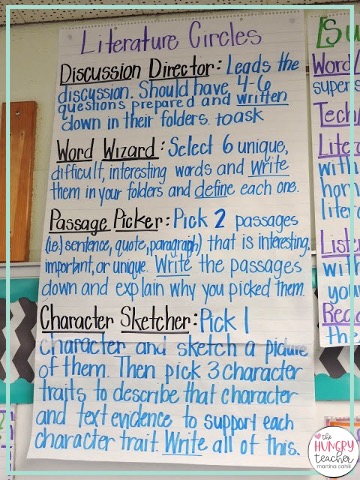
This is the chart we made in 6th grade to help students make sure they do their literature circle jobs each week.
I later made them packets to have the job descriptions, and eventually the jobs evolved with the groups.
However, I had some groups that needed a lot more structure and support, and we would sometimes work on their literature circles reading and homework during small group.
SMALL GROUP ANECDOTAL NOTES
When I taught fifth grade self-contained, I just had a tab for each group I met with. When I went to sixth, I thought I would have a binder for each of my two classes, and then dividers for each group. The multiple binders situation just didn’t work for me.
My groups did fluctuate and move around a lot. I was always switching kids. This meant my “perfectly” labeled binders weren’t useful because they didn’t match the groups at all. I realized I needed more flexibility with my binders and with my forms for groups. The notes needed to drive my whole group and small group instruction. They also needed to be there to collect information about my students. It made sense that I just needed to find a system that worked for ME.
I went to one binder for both classes and labeled a tab for each day of the week. I could just flip to the day (instead of trying to find “the group”)
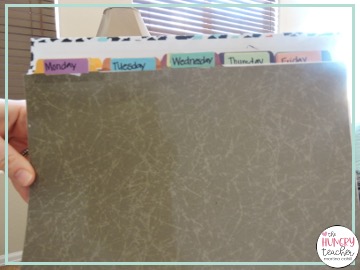
FLEXIBLE SMALL GROUP ANECDOTAL NOTES
Then I made my notes SUPER generic and SUPER flexible. This allowed me to write the names in, write the lesson in, and then make notes about the groups.
On top I made a place for the date and place to circle whether it was 6A or 6B. I put two of these pages behind each day of the week, so I would have one for each of my two classes. I then would look at my notes at the end of the week, move kids around as needed. Then I make my new small group plans for the following week.
Then I would move these “old notes” into a larger binder for reference and put two new sheets behind the day of the week.
Now in 7th and 8th, I just have this same note-catcher.
It’s now two-sided with two groups on each side, because I have four classes where I meet with one group per day.
I just put one note-catcher behind each day of the week.
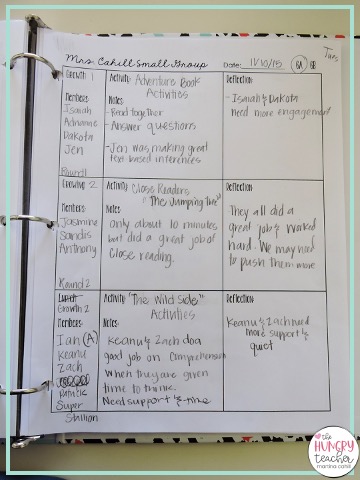
This is my more detailed note-catcher that I started to make as I realized that many of my students were still struggling with the same concepts. The super tiny words on the right-hand side is a checklist of skills specific students needed to work on. It helped make my small groups even more specific and needs based.
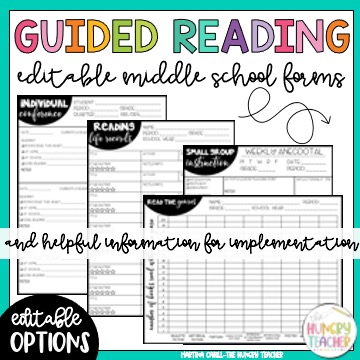
All of these forms are included in my guided reading resource specifically for middle school ELA.
CLICK HERE or on the image to get all these recording sheets and resources.
HOW I MAKE SMALL GROUPS WORK
During my last three years as a teacher, I think my BIGGEST struggle has been teaching small groups. I don’t care what anyone says…. it is so hard. There are kids off task, middles schoolers being middle schoolers, fake reading, and 45 students asking approximately 4,593,678 questions a day while you are trying to teach your groups.
That being said, small group instruction is one of the most beneficial things I have ever done, and over time, you get better at preventing and managing the above scenarios. If you stick with it, and learn as you go, you won’t know how you ever taught without small groups before.
I typically have these amazing fantasy that I will start small groups by week 6 of school… bahaha… *full disclosure here*… it was more like week 12 for me. I used to feel guilty about this, but I don’t anymore. My first year, I didn’t really do small groups until week 26 maybe (ha!)
It takes time, practice, research, and patience, but over the last three years I have figured it out… kind of :).
HOW DID I FIGURE IT OUT?
The best thing I ever did was read Daily 5 and Reading in the Wild. These two books shape everything I do.
I do my best to explain it, but I highly recommend reading them (easy reads, so simple, and just common sense from both).
WHAT ARE THE OTHER KIDS DOING?
Again, my routine is almost all based on The Daily 5 and Reading in the Wild. The following will show you what works best for me.
Now if the creators of “Daily 5” came into my room, they probably wouldn’t call it “Daily 5,” but I do and this is what works in my middle school classroom.
After I teach my lessons, I then ask students what they are going to do, do a quick Status of the Class check. I simply ask them what they’re reading and what page they’re on. I write it all down, and they get started. While they work on these, I meet with my groups.
You can get free, editable Status of the Class forms by clicking here.
DAILY FIVE CHOICES IN SIXTH GRADE
Students can choose from the following options during our Daily 5 rounds in sixth grade:

READ TO SELF
Students can read :). This is the only option they can choose for both of our rounds each day.
I believe it will NEVER hurt them if they choose to read for both of our rounds.
Some of my reluctant readers don’t choose this option at the start of the year, but this system allows me to work to put books in their hands so they slowly start to choose this option more frequently. I really try not to force anything.
Yes, I do still work ALL year long with some of my students to build up their love of reading, but it’s minimal and it’s just something I am ALWAYS working on with those students.
LITERATURE CIRCLES
What students are doing:
- Meet with their group to read their book together.
- Students might meet with their group to work on their literature circle homework together.
- Simply just discuss the book.
- They can also just read their Literature Circle group or work on their homework individually.
I do literature circles very differently now, but this was how the structure worked when I taught sixth grade ELA.

This is a chart I made based on their roles. This is especially helpful for my sixth grade students who struggle with organization and remembering information.
I definitely do literature circles in so many different want but I do like to have forms for some groups.
When the pandemic hit, I also made sure to make digital versions, so students could still collaborate.
Click here or on the image to get the Literature Circle forms for middle school resource.
LEXIA COMPUTER LITERACY PROGRAM
This is a computer literacy program our district purchased for us. It is self-paced.
I love this option because many of my reluctant readers choose this. (That’s not what I love it though! ha!). But it allows me to meet with my other kids at the start of the year and support them into being really independent.
I then can start slowly working with my reluctant readers to show them that books are better than a computer program.
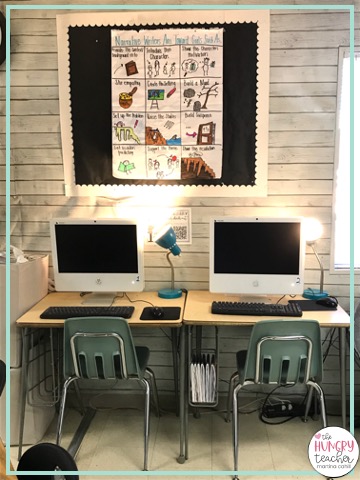
Many of these students could be a disruption at the beginning of the year.
This helps alleviate that, over time they get bored of the program and the novelty wears off, and I slowly get to try and build more readers. It’s just a good teacher tool for me to have.
When I went to middle school ELA, I used commonlit.org. In my opinion, it’s one of the best program for middle school ELA teachers.
WORK ON WRITING
Students can do the following activities during work on writing:
- Free write in their writing notebooks.
- Conduct research for a writing topic.
- type a writing piece they want to publish.
- Work together on stories.
- Write about their reading.
For writing workshop I use Kelly Anne’s Writing Workshop units. Writing is a different part of our day, but this is where I get my lessons, and where a lot of my students often get their ideas for their writing.
SMALL GROUP SCHEDULE
I wanted to explain what I do during my lessons and how they then lead into my small group time. I know this will not be helpful to all teachers, but I know that I like seeing how other classrooms and schedules work. It can often help me to figure out how I should set up my schedule.
I will start by revisiting my sixth grade ELA schedule. I was blessed with the ability to make the schedule I have, because I teach middle school in an Elementary School, so our kids only switch a few times a day.
Anyway, I have about 100-110 minutes with each class for ELA.
This middle school and upper elementary small group and guided reading n blog post is part of a three part series. This is part two of three blog posts all about how I implemented guided reading and small groups in my middle school classrooms. Click on any of the links to be taken to each of the posts in the series:
- One: Guided Reading and Small Group
- Two: Student Routines, Daily 5, and More
- Three: Small Group Alongside Curriculum and Whole Group
CLICK HERE to get my Middle School Guided Reading Recording Sheets sent straight to your inbox.
get free middle school guided reading forms sent
to your inbox
Subscribe to The Hungry Teacher and get five of my middle school guided reading forms sent straight to your inbox. You’ll also get access to all of my exclusive freebies and teaching ideas.
Want a sneak peek at teaching The Hungry Teacher way—with support, structure, and strategy?
When you join the waitlist for The Hungry Teacher’s Hub membership, you get three free classroom-ready resources: a theme unit, an expository writing unit, and a grammar unit introducing mentor sentences. Plus, you’ll get immediate access to a selection of exclusives from the Hub, including editable sub plans, pacing guides, and more.
No strings attached. Just resources you can use right now—and a heads-up when the Hub opens.
3 Free Middle School ELA Units—yours to keep!
JOIN THE WAITLIST + A FREE GIFT
Where to next, line leader?
Welcome to The Hungry Teacher! We create resources that are easy to use, practical, and get results. Teach with confidence—and make it home before dinner.
xo, the hungry teacher
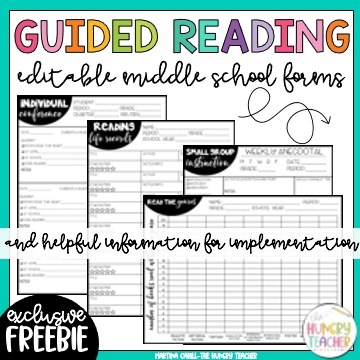
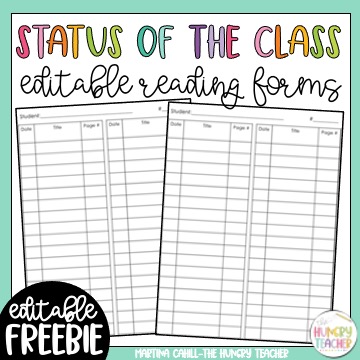
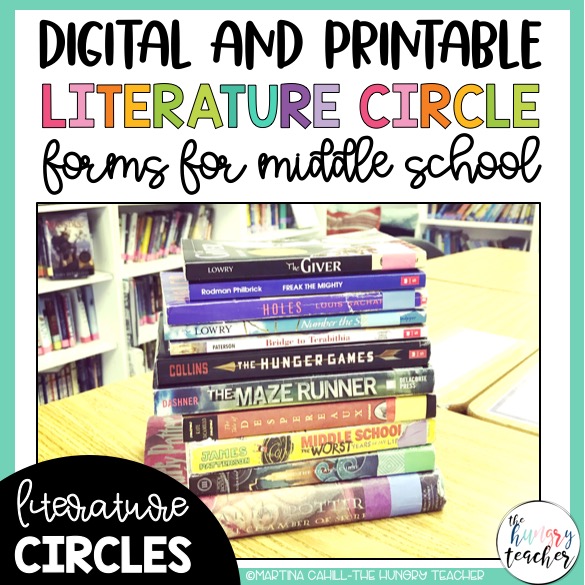
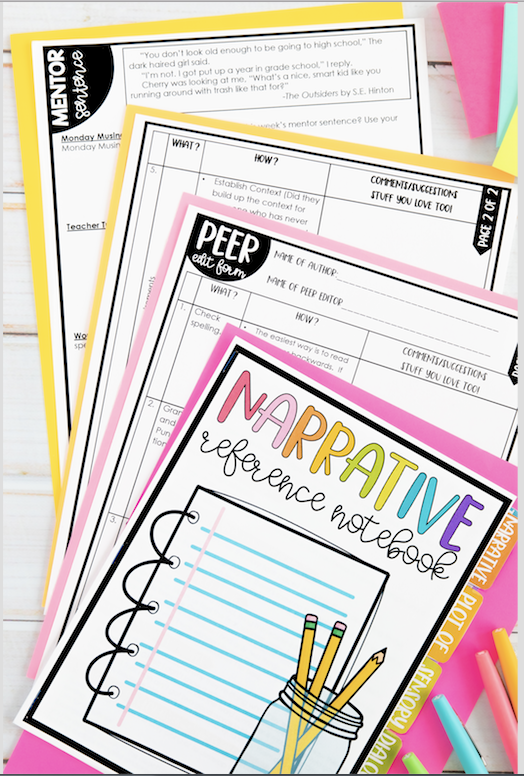
Thanks so much for this series! I bought your novel study bundle this summer and I have been using those with my 5th graders as a whole group read aloud. It's a great addition to my ELA block and my kids really enjoy it. It has also been fun for me using books I probably never would have read aloud otherwise (Freak the Mighty, Locomotion).
I have an 8:1:1 self-contained class but my biggest struggle with reading groups is having only 1 student at a certain reading level. For example I currently have students at levels E, F, H, K, N, P (2 students) and Q. How would you recommend grouping them for small groups?
Thanks Martina!
Thank you so much for your sweet words! So glad you love teaching with novels. I wish I could get the whole world reading with novels!
As for groups, I know what a struggle than can be! I don't have the same range, but my 6th graders do range from levels O-Z. My struggling readers tend to vary the most. That being said, I would pull the E, F, and H and pick a text that is an F and really try to dig deep with all of them. I have found (sometimes the hard way) that it's not always the text, but what you do with it. For me, my goal is always just making them love reading, so who cares if your K is reading a G! :). Just have them really analyze what they're reading. That's how I feel about the novels too! When I read Holes, with my 5th graders, it was technically to low and too high for more than 1/2 my class, but how they had to write and response during that time was how I differentiated and really pushed them as readers and writers.
I know you are probably already doing some of these things, or thinking about them, but sometimes it's just nice to hear it from someone else's voice! Hope this helps!
MUAH!
Martina
I was wondering what your Super Stallion time looks like? I work in a relatively small school, that is relatively new and we are trying to implement an intervention block but we are struggling with a good format. Any advice or help would begreat! I would be happy to chat via email kwalker@mht-stl.org
Hi! Thank you so much for reading my post.
So my Super Stallion time is a SUPER work in progress. K-3 in our building uses "Burst Groups." I literally have no clue what they are, but they divide the kids up based on their DIBELS scores, each teacher then prints the lessons for their groups of kids, and then teach the lessons.
Fourth and Fifth grade, have three classes each. Again, they have them divided into three groups: Intensive, Proficient, and Enrichment.
The intensive kids do rotations with their teacher, so he meets with 2 small groups per day to work on skills they need (his group is also the smallest so he can really meet their needs). The proficient kids' teachers does novel studies, in a whole group setting. The enrichment teacher uses Junior Great books. Essentially, they read a short story, have a socratic seminar, and write.
My whole set up is different because I'm in 6th grade, and I have been making it up as I go. In general, it's like a controlled Daily 5. There are four days a week of intervention and my kids go to one station each day: Meet with their literature circle, Lexia, Read to Self, or Teacher. I make the schedule, so I can control the groups. I despise rotations and kids moving to different stations during a set time in one session, so I like that they focus on one station each day. Sometimes my 6th graders get bored and/or restless and I will do some whole group close reading or discussions to break it up.
Hope that helps, but feel free to ask more questions if you need clarification.
Thanks!
Martina
I love your blog, and I could really use some advice! I am an 8th grade ELA teacher and have 47 minute class periods. I am desperate to implement guided reading into my classroom, and my biggest stumbling block at this point is wrapping my head around the scheduling of the class period and week and what the rest of my class is doing while I'm meeting with small groups. I see that your kids have Daily 5 Choices–so once they choose, is that their activity for the remainder of the ELA time? I notice you mentioned in the above comment that you don't like kids moving to different stations during a set time, and I agree. I think that would invite behavior issues that would interfere with my small group time. So would you suggest that I schedule certain students to complete certain stations each day while I meet with small group OR allow them the choice of station or daily 5, but do not allow them to move to more than one station per day. I'm not sure if my question makes sense–my mind is all over the place trying to get this under control so that I can help my readers!! Thank you so very much!!
How do you hold the kids accountable at each station?